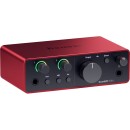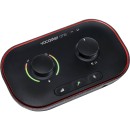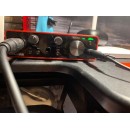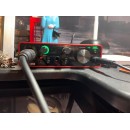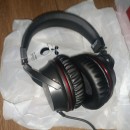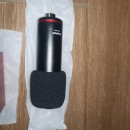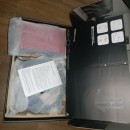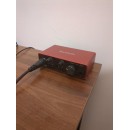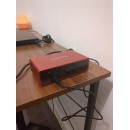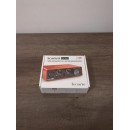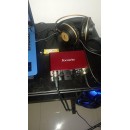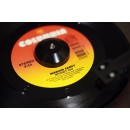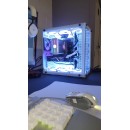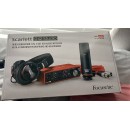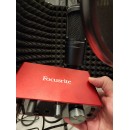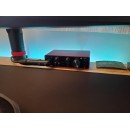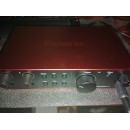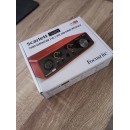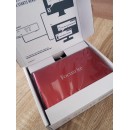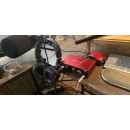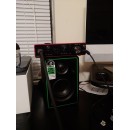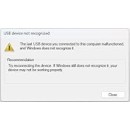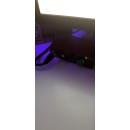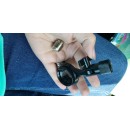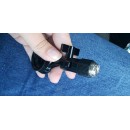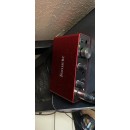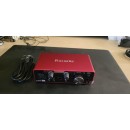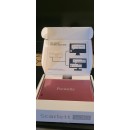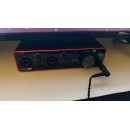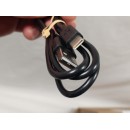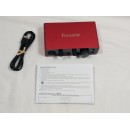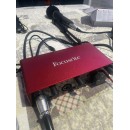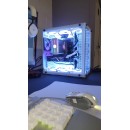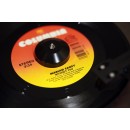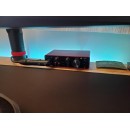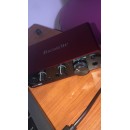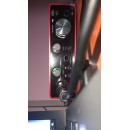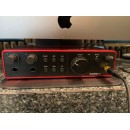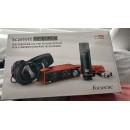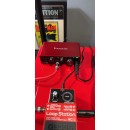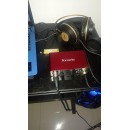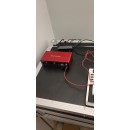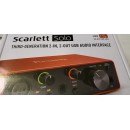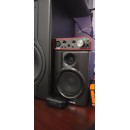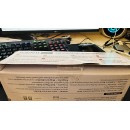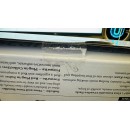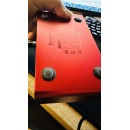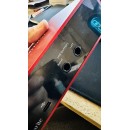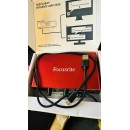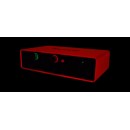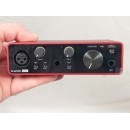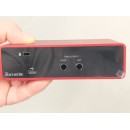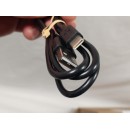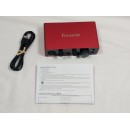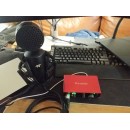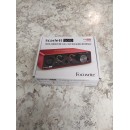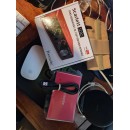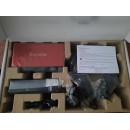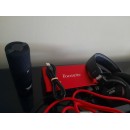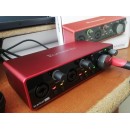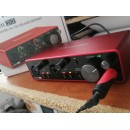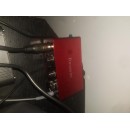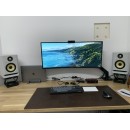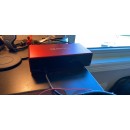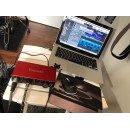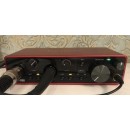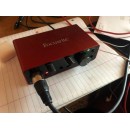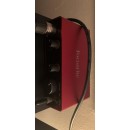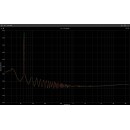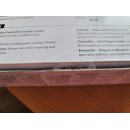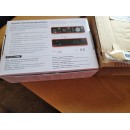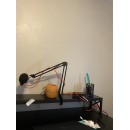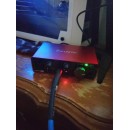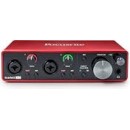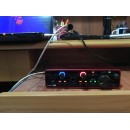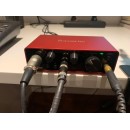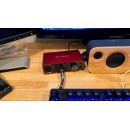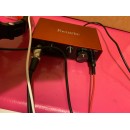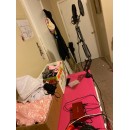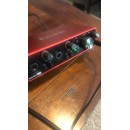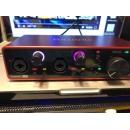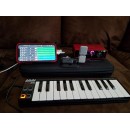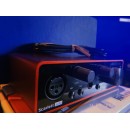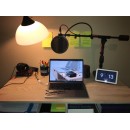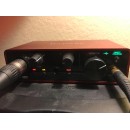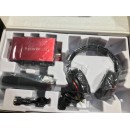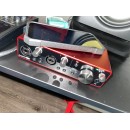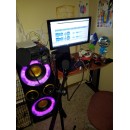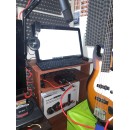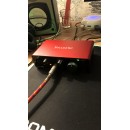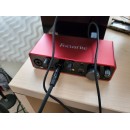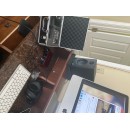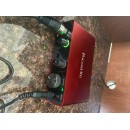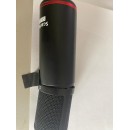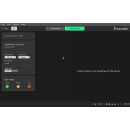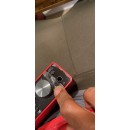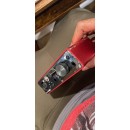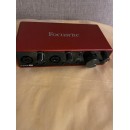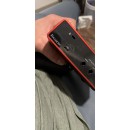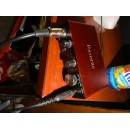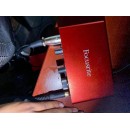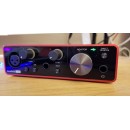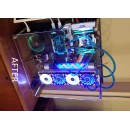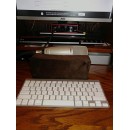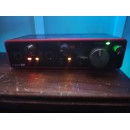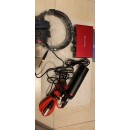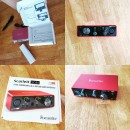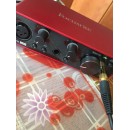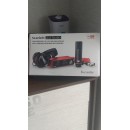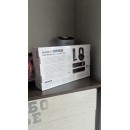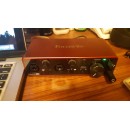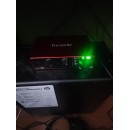Focusrite Vocaster One vs Scarlett Solo (4th Gen): A Comprehensive Comparison
The Focusrite Vocaster One is designed primarily for podcasters, vloggers, and content creators who focus on vocal recordings. It features an intuitive interface with a single XLR input, making it simple for solo creators to capture high-quality audio. The unit includes enhanced preamps that offer up to 70dB of gain, ensuring clear and professional-sounding recordings. It also has built-in features like Auto Gain, Enhance, and a mute button, providing users with quick and effective control over their audio settings. The Vocaster One connects via USB-C, ensuring fast data transfer and compatibility with modern devices. Its compact and user-friendly design makes it ideal for on-the-go recording.
On the other hand, the Focusrite Scarlett Solo USB-C Audio Interface (4th Generation) is a versatile and robust choice for musicians, producers, and anyone needing high-fidelity audio input for various instruments and vocals. It comes with one Scarlett mic preamp with 56dB of gain and an instrument input, allowing users to record vocals and instruments simultaneously. The 4th Generation model boasts improved audio performance with ultra-low latency, high headroom, and a dynamic range of over 120dB. This interface also features Focusrite’s acclaimed Air mode, which adds brightness and presence to your recordings. Additionally, the Scarlett Solo includes a suite of software tools and plugins that enhance the recording experience. Its USB-C connectivity ensures quick and reliable data transfer, making it a solid choice for studio and home recording setups.
In summary, the Focusrite Vocaster One is tailored for vocal-centric content creation with user-friendly features, while the Focusrite Scarlett Solo (4th Generation) offers greater versatility for recording a range of audio sources with superior sound quality. Both interfaces provide excellent performance and connectivity, catering to different types of users and recording needs.
Specifications, Advantages, and Disadvantages
| User Rating Based on Analysis of Reviews | |
|---|---|
|
Show More |
| Pros: | |
|---|---|
|
|
| Cons: | |
|---|---|
|
|
| Key Specs | |
|---|---|
| Channels of I/O | |
| Analog: 2 Inputs / 2 Outputs at 192 kHz |
1 Input / 2 Outputs |
| Maximum Sampling Rate | |
| 192 kHz / 24-Bit | 48 kHz / 24-Bit |
| Number of Microphone Inputs | |
| 1 | 1 Preamp |
| Analog Audio I/O | |
| 1x XLR 3-Pin Balanced Mic Input 1x 1/4" TS Unbalanced Line/Hi-Z Input (Front Panel) 2x 1/4" TRS Balanced Monitor Output 1x 1/4" TRS Headphone Output (Front Panel) |
1x XLR 3-Pin Balanced Mic Input 1x 1/8" / 3.5 mm TRRS Unbalanced Smartphone In/Out 1x 1/4" TRS Unbalanced Headphone Output 2x 1/4" TRS Balanced Monitor Output 1x 1/8" / 3.5 mm TRS Unbalanced Main Output |
| Host Connection | |
| 1x USB-C | 1x USB-C (Class-Compliant) |
| OS Compatibility | |
| macOS Windows |
macOS Windows iPadOS |
| Power Requirements | |
| USB Bus Power, USB Power Adapter (Not Included) | AC/DC Power Adapter (Not Included) or USB Bus Power |
The Vocaster One offers a single channel input and two outputs, supporting a maximum sampling rate of 48 kHz at 24-bit resolution. It features one XLR 3-pin balanced mic input, a 1/8" TRRS unbalanced smartphone in/out, and a 1/4" TRS unbalanced headphone output. Additionally, it includes two 1/4" TRS balanced monitor outputs and one 1/8" TRS unbalanced main output. The Vocaster One connects via USB-C and is compatible with macOS, Windows, and iPadOS. It can be powered through an AC/DC power adapter (not included) or USB bus power.
In contrast, the Scarlett Solo (4th Generation) boasts a more advanced setup with two analog inputs and two outputs, achieving a higher maximum sampling rate of 192 kHz at 24-bit resolution. Similar to the Vocaster, it features one XLR 3-pin balanced mic input but also includes a 1/4" TS unbalanced line/Hi-Z input on the front panel. The Scarlett Solo has two 1/4" TRS balanced monitor outputs and a 1/4" TRS headphone output, which is also located on the front panel. This interface connects via USB-C and is compatible with macOS and Windows. It operates on USB bus power or with a USB power adapter (not included).
In summary, while both audio interfaces serve the primary function of audio input and output, the Vocaster One is geared towards simpler setups with smartphone integration, whereas the Scarlett Solo offers higher sampling rates and additional inputs for more complex recording scenarios.
| General | |
|---|---|
| Channels of I/O | |
| Analog: 2 Inputs / 2 Outputs at 192 kHz |
1 Input / 2 Outputs |
| Maximum Sampling Rate | |
| 192 kHz / 24-Bit | 48 kHz / 24-Bit |
| Number of Microphone Inputs | |
| 1 | 1 Preamp |
| Built-In Microphone | |
| Input Level Adjustment | |
| 2x Knob | 1x Knob |
| Expansion Slots | |
In contrast, the Focusrite Scarlett Solo (4th Generation) offers greater versatility with its 2 analog inputs and 2 outputs, allowing for more complex recording setups. It boasts a significantly higher maximum sampling rate of 192 kHz at 24-bit, making it ideal for musicians and audio professionals seeking superior audio quality. Like the Vocaster One, it also has a single microphone input, but it provides enhanced control with two separate input level adjustment knobs. This feature allows users to fine-tune their sound more precisely, accommodating a broader range of recording scenarios.
Both interfaces do not include built-in microphones or expansion slots, focusing instead on providing high-quality input options. However, the Scarlett Solo’s higher sampling rate and additional input channel make it a more powerful choice for users who require more from their audio interface. Ultimately, the choice between these two models will depend on the specific needs of the user, whether it be the straightforward approach of the Vocaster One or the enhanced capabilities of the Scarlett Solo.
| Signal Processing | |
|---|---|
| Gain/Trim Range | |
| Mic/Line Inputs: Up to +69 dB Hi-Z Inputs: 62 dB |
Up to 70 dB |
Starting with the Vocaster One, it features a gain/trim range of up to 70 dB, providing ample headroom for various microphone types. However, it lacks a high-pass filter and pad functionality, which may limit its versatility in managing low-frequency noise or handling louder sources. The interface does include a mute function for each input channel, allowing for greater control during live sessions or recordings.
In contrast, the Scarlett Solo (4th Generation) offers a slightly lower gain/trim range for its mic/line inputs, which is up to 69 dB, while its Hi-Z inputs can handle up to 62 dB. This makes it suitable for recording instruments directly. Although it also does not feature a high-pass filter, its gain structure is designed to accommodate a broad range of input sources effectively.
Overall, the Vocaster One provides a higher maximum gain and a more user-friendly approach with its mute functionality, while the Scarlett Solo is tailored for musicians with its Hi-Z input capabilities, making both interfaces suitable for different audio recording needs.
| Connectivity | |
|---|---|
| Analog Audio I/O | |
| 1x XLR 3-Pin Balanced Mic Input 1x 1/4" TS Unbalanced Line/Hi-Z Input (Front Panel) 2x 1/4" TRS Balanced Monitor Output 1x 1/4" TRS Headphone Output (Front Panel) |
1x XLR 3-Pin Balanced Mic Input 1x 1/8" / 3.5 mm TRRS Unbalanced Smartphone In/Out 1x 1/4" TRS Unbalanced Headphone Output 2x 1/4" TRS Balanced Monitor Output 1x 1/8" / 3.5 mm TRS Unbalanced Main Output |
| Phantom Power | |
| 48 V, Selectable On/Off | 48 V, Selectable On/Off |
| Digital Audio I/O | |
| Host Connection | |
| 1x USB-C | 1x USB-C (Class-Compliant) |
| Host Connection Protocol | |
| USB 2.0 | USB 3.0 / 3.1/3.2 Gen 1 |
| USB (Non-Host) | |
| Sync I/O | |
| Network I/O | |
| MIDI I/O | |
The Vocaster One is primarily designed for podcasters and content creators, boasting a unique input setup that includes a single XLR 3-Pin balanced mic input, a 1/8" TRRS unbalanced smartphone input, and a 1/4" TRS unbalanced headphone output. It supports two 1/4" TRS balanced monitor outputs and one 1/8" TRS unbalanced main output. The interface provides 48 V phantom power that is selectable on/off, which is essential for using condenser microphones. Connectivity is facilitated through a USB-C port that supports USB 3.0 / 3.1/3.2 Gen 1 protocols, but it lacks digital audio I/O, sync I/O, network I/O, and MIDI I/O.
On the other hand, the Scarlett Solo (4th Generation) targets musicians and audio engineers. It features a single XLR 3-Pin balanced mic input alongside a 1/4" TS unbalanced line/Hi-Z input on the front panel, allowing for greater versatility in instrument connections. Similar to the Vocaster One, it includes two 1/4" TRS balanced monitor outputs and a 1/4" TRS headphone output. The Scarlett Solo also offers 48 V phantom power that can be turned on or off. However, it connects via USB-C using the USB 2.0 protocol and also lacks digital audio I/O, sync I/O, network I/O, and MIDI I/O capabilities.
In summary, while both interfaces feature phantom power and a robust analog audio input setup, the Vocaster One is tailored more for podcasters and mobile creators, integrating smartphone connectivity, whereas the Scarlett Solo caters to musicians with its additional line/Hi-Z input. The choice between the two ultimately depends on the specific recording needs and preferences of the user.
| Performance | |
|---|---|
| Frequency Response | |
| XLR Mic Inputs: 20 Hz to 20 kHz ±0.06 dB 1/4" Line Inputs: 20 Hz to 20 kHz 0.05 dB 1/4" Hi-Z Inputs: 20 Hz to 20 kHz 0.15 dB |
Inputs: 20 Hz to 20 kHz +0/-0.5 dB 1/8" / 3.5 mm Line Outputs: 20 Hz to 20 kHz 1/4" Line Outputs: 20 Hz to 20 kHz ±0.15 dB 1/4" Headphone Outputs: 20 Hz to 20 kHz ±0.5 dB |
| Maximum Input Level | |
| XLR Mic: 9.5 dBu 1/4" Line: 22 dBu 1/4" Hi-Z: 12 dBu |
Mic Inputs: +12.5 dBu (Min Gain) Aux Inputs: +1 dBu |
| Maximum Output Level | |
| 1/4" Line: +16 dBu |
1/4" Line Outputs: +14 dBu 1/4" Headphone Outputs: +6.5 dBu at 0 dBFS 1/8" / 3.5 mm Aux Outputs: -26 dBu 1/8" / 3.5 mm Line Outputs: -24.5 dBu |
| Headphone Output Power | |
| 1/4": 32 mW into 33 Ohms 22 mW into 300 Ohms |
28 mW into 33 Ohms 8.5 mW into 270 Ohms |
| Impedance | |
| XLR Mic Inputs: 3 Kilohms 1/4" Line Inputs: 60 Kilohms 1/4" Hi-Z Inputs: 1 Megohms 1/4" Line Outputs: 200 Ohms 1/4" Headphone Outputs: < 50 Ohm |
Mic Inputs: 3 Kilohms Aux Inputs: 18 Kilohms 1/4" Line Outputs: 440 Ohms 1/4" Headphone Outputs: 5 Ohms 1/8" / 3.5 mm Outputs: 220 Ohms |
| THD+N | |
| XLR Mic Inputs: -100 dB (at Minimum Gain) 1/4" Line Inputs: -100 dB (at 8 dB Gain) 1/4" Hi-Z Inputs: -80 dB (at Minimum Gain) 1/4" Line Outputs: -100 dB (at Minimum Gain) 1/4" Headphone Outputs: -97 dB (at 33 Ohms) -102 dB (at 300 Ohms) Digital A/D Converters: -110 dB Digital D/A Converters: -115 dB |
Inputs: ≤ -94 dB 1/4" Line Outputs: ≤ -96 dB 1/4" Headphone Outputs: -96 dB 1/8" / 3.5 mm Outputs: -73 dB |
Starting with the frequency response, the Vocaster One provides a range of 20 Hz to 20 kHz for its inputs, outputs, and headphone outputs with minimal variation. In comparison, the Scarlett Solo also boasts a frequency response of 20 Hz to 20 kHz for its XLR mic, line, and Hi-Z inputs, with slightly tighter tolerances, indicating a more precise response across the frequency spectrum.
When considering maximum input levels, the Vocaster One has a maximum mic input level of +12.5 dBu and +1 dBu for aux inputs. The Scarlett Solo, however, offers a higher maximum input level of +9.5 dBu for XLR mics, +22 dBu for line inputs, and +12 dBu for Hi-Z inputs, making it more versatile for various recording scenarios.
In terms of maximum output levels, the Vocaster One has +14 dBu for 1/4" line outputs, while the Scarlett Solo offers +16 dBu for its 1/4" line outputs. This slight difference may influence the overall volume output in certain applications. The headphone output power of the Vocaster One is rated at 28 mW into 33 Ohms and 8.5 mW into 270 Ohms, contrasting with the Scarlett Solo's 32 mW into 33 Ohms and 22 mW into 300 Ohms, suggesting better headphone performance with the Solo.
Impedance specifications show that both interfaces have 3 Kilohms for mic inputs. However, the Scarlett Solo features higher impedance for its 1/4" line inputs at 60 Kilohms and 1 Megohm for Hi-Z inputs, compared to the Vocaster One's 18 Kilohms for aux inputs. This could affect the performance with certain instruments and microphones.
Dynamic range is another critical area where the Scarlett Solo excels, with a dynamic range of 113 dBA for its mic and line inputs, and up to 120 dB for line outputs. The Vocaster One, although not explicitly listed, features a THD+N of less than -94 dB for inputs and -96 dB for line outputs, which indicates good performance but not as high as the Scarlett's capabilities.
Overall, the Focusrite Vocaster One is designed more for podcasting and streaming, while the Focusrite Scarlett Solo is tailored for music recording with its higher input levels and dynamic range, making it a more suitable choice for musicians and recording engineers.
| Digital Audio | |
|---|---|
| Sample Rates | |
| 44.1 / 48 / 88.2 / 96 / 176.4 / 192 kHz | Up to 48 kHz |
| Bit Depths | |
| 24-Bit | 24-Bit |
| Sync Sources | |
| Internal | Internal |
In contrast, the Focusrite Scarlett Solo USB-C Audio Interface (4th Generation) provides a more versatile range of sample rates, supporting 44.1 kHz all the way up to 192 kHz. This extensive range allows for higher fidelity recordings, making it suitable for musicians and audio professionals who demand flexibility in their projects. Like the Vocaster One, the Scarlett Solo also supports a bit depth of 24-bit and features internal sync sources, but its broader sample rate options make it a more adaptable choice for varied recording scenarios.
Overall, while both interfaces offer 24-bit depth and internal sync, the Vocaster One is tailored for simpler, focused applications like podcasting, with a capped sample rate of 48 kHz. The Scarlett Solo, on the other hand, caters to a broader audience with higher sample rate capabilities, making it a better fit for those needing more advanced audio recording options.
| Audio Storage & Playback |
|---|
| Compatibility | |
|---|---|
| OS Compatibility | |
| macOS Windows |
macOS Windows iPadOS |
In terms of OS Compatibility, the Vocaster One supports macOS, Windows, and iPadOS, making it versatile for various users. On the other hand, the Scarlett Solo is also compatible with macOS and Windows but has limited mobile compatibility as it only works with iPadOS through a mobile app. This difference gives the Vocaster One a slight edge for users who want to utilize multiple operating systems, including direct support for iPad.
When it comes to Included Software and Plug-Ins, the Vocaster One does not come with any included software or plug-ins, while the Scarlett Solo also lacks bundled software. This aspect suggests that both interfaces focus on hardware quality rather than software packages, which may appeal to users who prefer to select their own software solutions.
In terms of Mobile Device Compatibility, the Vocaster One is designed to work with iPad devices that have a USB-C port, while the Scarlett Solo is explicitly compatible only with iPadOS using a mobile application. This specific compatibility may influence users who wish to record directly from their mobile devices.
Lastly, regarding Required Hardware, both models require a USB-A port for connection, indicating that users will need to ensure they have the appropriate hardware for setup. The Vocaster One additionally requires an internet connection for registration and software/driver downloads, which is a consideration for users who may have limited internet access.
In summary, while both interfaces provide essential features for audio recording, the Focusrite Vocaster One offers broader OS compatibility and direct support for mobile devices, making it a more versatile choice for diverse recording environments. Conversely, the Scarlett Solo remains a solid option for users focused on desktop recording with iPad compatibility through a dedicated app.
| Power | |
|---|---|
| Power Requirements | |
| USB Bus Power, USB Power Adapter (Not Included) | AC/DC Power Adapter (Not Included) or USB Bus Power |
| AC/DC Power Adapter | |
| 5 VDC at 900 mA | 5 VDC at 1 A (Not Included) |
| Power Consumption | |
| 4.5 W | 4 W (Maximum) |
The Focusrite Vocaster One requires an AC/DC power adapter (not included) or can be powered via USB bus power. It operates on a 5 VDC at 1 A specification and has a maximum power consumption of 4 W. This setup allows for flexible powering options, especially for users who may prefer the convenience of AC power.
In contrast, the Focusrite Scarlett Solo (4th Generation) relies on USB bus power as its primary source but can also be powered using a USB power adapter (not included). It operates at a slightly lower voltage of 5 VDC at 900 mA and has a maximum power consumption of 4.5 W. This interface is designed for users who prioritize simplicity and portability, making it ideal for mobile recording scenarios.
Overall, while both interfaces are designed to deliver high-quality audio, the Vocaster One offers more versatility in power options, whereas the Scarlett Solo focuses on ease of use with its USB power reliance.
| Physical | |
|---|---|
| Dimensions | |
| 5.63 x 3.78 x 1.79" / 14.3 x 9.6 x 4.55 cm | 7.7 x 4.4 x 2" / 19.5 x 11.3 x 5 cm |
| Weight | |
| 0.8 lb / 363.0 g | 0.8 lb / 0.4 kg (without Accessories) |
The Focusrite Vocaster One boasts a dimension of 7.7 x 4.4 x 2 inches (19.5 x 11.3 x 5 cm) and a lightweight design at 0.8 lb (0.4 kg), excluding accessories. A notable feature of this model is its Kensington Security Slot, providing an added layer of security for users concerned about theft, making it a suitable choice for mobile podcasters or content creators who frequently work in different locations.
In contrast, the Focusrite Scarlett Solo (4th Generation) is more compact, measuring 5.63 x 3.78 x 1.79 inches (14.3 x 9.6 x 4.55 cm) and sharing the same weight of 0.8 lb (363.0 g). This smaller footprint makes it an excellent option for those with limited space or for musicians who require a portable solution without additional security features.
Overall, while both interfaces share a similar weight and are designed for portability, the Vocaster One offers additional security features and a slightly larger size, making it more suited for mobile applications. The Scarlett Solo, with its more compact design, is ideal for users prioritizing space efficiency.
| Packaging Info | |
|---|---|
| Package Weight | |
| 1.305 lb | 1.645 lb |
| Box Dimensions (LxWxH) | |
| 7.2 x 6.1 x 2.5" | 10.1 x 8.1 x 3.2" |
The Focusrite Vocaster One has a package weight of 1.645 lb and dimensions of 10.1 x 8.1 x 3.2 inches. This design suggests a slightly bulkier profile, making it potentially more suitable for users looking for a more robust interface that may accommodate additional features or inputs.
In contrast, the Focusrite Scarlett Solo weighs 1.305 lb and has more compact dimensions of 7.2 x 6.1 x 2.5 inches. This smaller form factor makes the Scarlett Solo a more portable option, ideal for musicians or podcasters who prioritize mobility without sacrificing audio quality.
Overall, the Vocaster One is designed for users who may require a larger interface with possibly more options, while the Scarlett Solo caters to those seeking a lightweight and compact solution for their audio needs.
| Customer Images | |
|---|---|
| Videos | |
|---|---|
|
|
|
